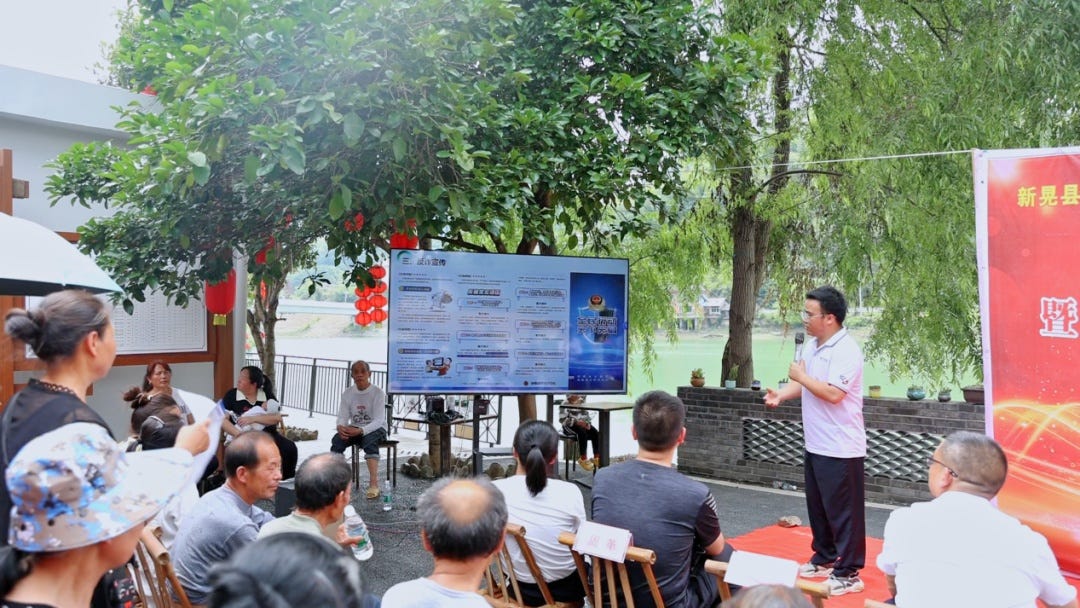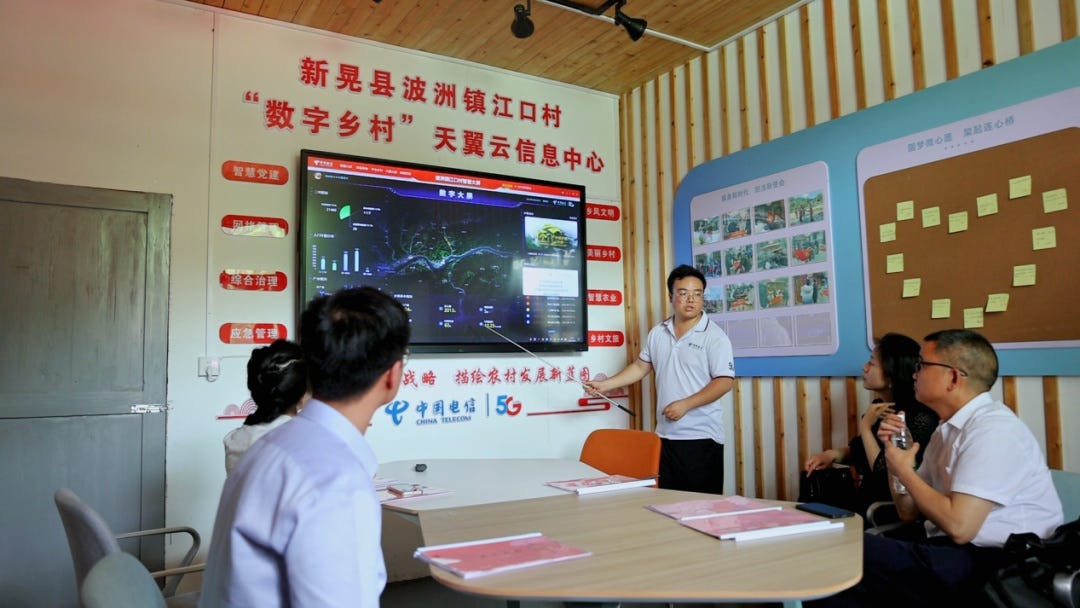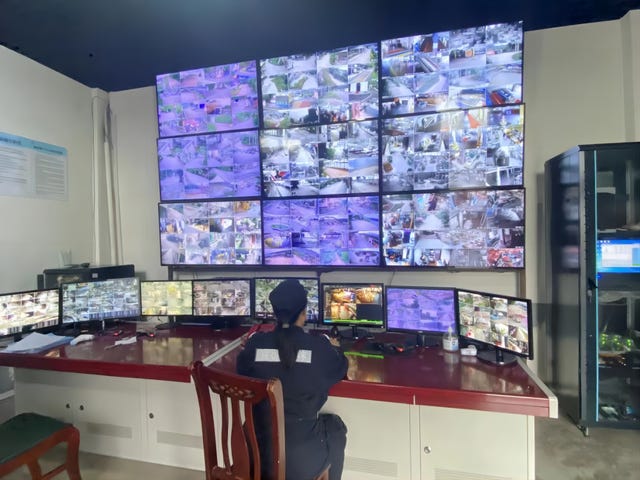The Quiet Revolution: Smart Villages Transforming Rural China
Digital Innovation, Cultural Heritage, and New Governance Challenges.
China’s countryside is undergoing a consequential transformation. The rise of ‘smart villages’ (智慧乡村)—rural communities adopting digital technologies—reflects the government’s broader push for digital integration. However, this shift is not merely about implementing new technologies; it represents a reconfiguration of rural society, altering economic structures, governance mechanisms, and community interactions in ways that demand deeper scrutiny.
Rural China has faced challenges such as population decline, economic stagnation, and an increasing digital divide for decades. Many villages have struggled to retain younger generations, who often migrate to cities in search of better opportunities. Smart village initiatives attempt to reverse this trend by embedding digital infrastructure into rural life, fostering new business models, and streamlining governance. However, while these efforts hold promise, they also introduce new complexities—balancing modernisation with traditional livelihoods, economic inclusion with automation, and digital empowerment with concerns over state surveillance.
The Mechanics of the Smart Village
A smart village integrates digital tools to improve rural life. The government’s Digital Rural Development Strategy (数字乡村发展战略) and China Rural E-commerce Development Plan (中国农村电子商务发展规划) are key initiatives supporting this transition. Through 5G networks, AI-driven farming, and Internet of Things (IoT, 物联网) applications—such as smart irrigation systems and automated pest control—farmers can monitor crops remotely, optimise yields, and reduce costs. These tools also enable precision farming, which improves efficiency and sustainability.
While the rise of digital tools in rural China promises efficiency and convenience, it is important to consider whether the term ‘smart’ truly captures the varied realities of these communities. Is a village ‘smart’ simply because it has adopted a few technological innovations, or does the label imply a level of uniformity, readiness, and success that many rural areas have yet to achieve? The uneven implementation of digital infrastructure and the persistence of rural challenges—such as lack of access, digital literacy gaps, and unequal economic opportunities—raise important questions about whether these villages are indeed ‘smart’ or simply in the early stages of technological integration.
E-commerce platforms such as Pinduoduo (拼多多) and Taobao Villages (淘宝村) allow farmers and rural entrepreneurs to sell their products directly to consumers, bypassing intermediaries in traditional supply chains. This direct-to-consumer model reduces costs and increases profits for small-scale farmers, who can leverage online marketing, bulk-order discounts, and live-streaming sales to reach urban buyers. For instance, villages in Zhejiang and Shandong provinces have built Taobao Villages, where local cooperatives use digital platforms to sell fresh produce, handmade goods, and speciality agricultural products.
Beyond economics, digital platforms are now central to village governance, welfare distribution, and education, restructuring long-standing local practices. The role of digitalisation is not just to improve efficiency but to redefine how communities function.
One overlooked aspect of digitalisation is its role in preserving rural heritage and culture. In Guizhou province, the village of Danzhai has launched digital archives to document traditional Miao embroidery patterns, dialects, and folk music, ensuring that modernisation does not erase cultural identities. These digital repositories serve as educational tools to promote local artisans, integrating heritage preservation with economic opportunities.
Digital tourism initiatives are also gaining traction. In Wulingyuan, a UNESCO-listed scenic area in Hunan province, VR technology and live-streaming platforms allow urban audiences to remotely experience rural life, cultural festivals, and eco-tourism destinations. In Jiangsu, the village of Dongshan has used digital platforms to promote its tea culture, attracting urban consumers who participate in live-streamed tea-making workshops. These initiatives generate additional revenue for local communities and create new employment opportunities in rural areas.
Shifting Social and Economic Paradigms
Technology is altering social structures. Generational divides are particularly evident: younger residents use digital tools for business, while older villagers struggle with adoption. The increasing reliance on digital platforms means that older generations, who often lack digital literacy, risk being marginalised from economic opportunities. To bridge this gap, local governments and NGOs have launched training programmes, such as the “Rural Digital Skills Initiative” (农村数字技能培训计划) in Henan province, aimed at equipping elderly villagers with basic e-commerce and mobile banking skills.
Some younger people, drawn by digital entrepreneurship, are returning home. In Guangxi’s Rong’an county, for example, young entrepreneurs have used WeChat mini-programs and Douyin live streams to market local oranges directly to consumers, revitalising the local economy. However, long-term migration trends remain uncertain, as rural employment opportunities outside the digital economy remain limited.
Women’s roles are also changing. Previously marginalised in farming decisions, many now run online businesses, leveraging e-commerce for financial independence. In some areas, women are leading digital literacy initiatives and local governance. In Anhui’s Jinzhai County, female entrepreneurs have formed cooperative networks to teach other women how to use Taobao and Pinduoduo to sell handmade textiles and agricultural products, fostering a new wave of rural female-led businesses.
Smart agriculture and automated resource management are also transforming employment. Automated greenhouses, precision drone farming, and AI-driven livestock monitoring systems are increasing productivity but reducing the need for traditional farm labour. In Shandong, a large-scale smart farming initiative has led to fewer manual labour jobs, raising concerns over job sustainability for low-skilled workers. Some local governments have responded by promoting agritech training programmes to help farmers transition into higher-skilled roles in farm management and maintenance.
Additionally, digital finance is reshaping local economies. Mobile payment platforms such as Alipay and WeChat Pay have become integral to rural commerce, enabling small vendors to operate cashless businesses. However, financial inclusion remains uneven, with some villages lacking the infrastructure for widespread adoption. In poorer regions of Gansu and Yunnan, unreliable internet access and low smartphone penetration mean that many rural residents still rely on cash transactions, limiting their participation in the digital economy.
Governance, Surveillance, and Control
Digitalisation has streamlined local governance, with government platforms managing land use, taxation, and social welfare. However, these tools also expand state oversight. Facial recognition, data analytics, and surveillance systems allow authorities to track policy compliance, raising concerns over privacy and autonomy.
In Zhejiang’s Deqing County, smart governance platforms integrate real-time data on agricultural production, welfare distribution, and land use. While these systems improve efficiency, they allow officials to monitor individual households with unprecedented precision. Some villagers appreciate the convenience of digital governance, but others express unease about the extent of monitoring and potential misuse of personal data.
Another emerging factor is the integration of blockchain (区块链) in governance. Some pilot projects, such as in Jiangxi’s Wuyuan County, use blockchain to ensure resource allocation transparency and reduce local administration corruption. While this increases accountability, it raises concerns about data security and the potential for increased government control over rural affairs.
The New Rural-Urban Divide
Digitalisation could reduce rural-urban disparities, but gaps persist in infrastructure and digital literacy. Some remote villages still lack stable internet, limiting their ability to benefit from new technologies. While e-commerce offers economic opportunities, barriers such as weak logistics and limited funding prevent widespread success.
Digitalisation may reinforce rather than bridge inequalities. More developed regions advance quickly, while poorer areas struggle to keep up. Policymakers must ensure fair digital integration to prevent further economic divides.
One potential equaliser is the rise of rural education initiatives using EdTech (教育科技). Platforms such as Xuexi Qiangguo (学习强国) and DingTalk (钉钉) are bringing high-quality educational resources to village schools, reducing the knowledge gap between rural and urban students. However, these initiatives risk benefiting only a limited segment of rural youth without adequate teacher training and infrastructure.
Conclusion: The Double-Edged Sword of Tech Integration
In conclusion, the rise of smart villages in China represents a transformative shift in the country’s rural landscape, with promising opportunities and significant challenges. While digitalisation offers the potential for economic revitalisation, enhanced governance, and the preservation of cultural heritage, it also brings to light new social, economic, and ethical dilemmas. The generational divide in digital literacy, the risks of surveillance, and the deepening rural-urban disparity highlight the complexities of this transition. To fully realise the potential of smart villages, it will be crucial to address these issues with a balanced approach that ensures inclusivity, protects privacy, and bridges existing inequalities. Only through careful policy design and continued investment in infrastructure can rural China embrace the digital future without sacrificing its social fabric or cultural identity.










sometimes i feel the rural areas might just go down kicking and screaming. rural and urban life is obviously quite different in every country, but chinese rural areas are practically another world in almost every way.
implementing such infrastructure and improving conditions is indeed good, but i question how relevant it is to the people living in villages. the problems the government have to take on are unbelievably complex; on one hand, they need to make changes that the locals can agree to, on the other, they need to attract urban youth, and yet still need to consider cultural preservation, infrastructure, hygiene, and so on, all bundled into a relatively small set of directives.
it’s a situation filled with contradictory elements and i fear that any decision made necessarily implies something else sacrificed, be it quality of life, culture, or economy.